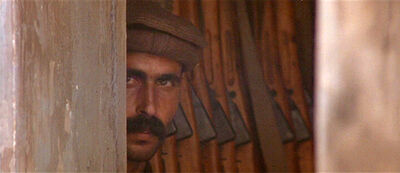
SKS
The SKS (Samozaryadnyj Karabin sistemy Simonova (Russian: Самозарядный карабин системы Симонова; Self-loading Carbine Simonov system) is a Soviet semi-automatic carbine chambered for the 7.62×39mm round, designed in 1943 by Sergei Gavrilovich Simonov.
It is a semi-automatic carbine that feeds from a fixed ten round magazines and accepts stripper clips, similar to a Mosin-Nagant. The SKS is known for being cheap and reliable. At one point, there was a buying rush for the SKS in the United States United States with many cheap Russian and Chinese SKS rifles flowing rapidly onto the market for prices of around $90 in the mid 90s.
The SKS was seen in Rambo III.
History and Design[]

Mousa's assistant stands in front of a row of SKS rifles, likely of either Chinese or Soviet origin.
In the early 1950s, the Soviets took the SKS carbine out of front-line service and replaced it with the AK-47; however, the SKS remained in second-line service for decades. It is still used as a ceremonial arm today. The SKS was widely exported, and was also produced by some former Eastern Bloc nations as well as China, where it was designated the "Type 56", East Germany as the Karabiner S and in North Korea as the "Type 63". The SKS is currently popular on the civilian surplus market in many countries, including the United States, Canada and New Zealand. It was one of the first weapons chambered for the 7.62×39mm M43 round, which was also used later in the AK-47.
The SKS has a conventional layout, with a wooden stock and rifle grip. The SKS is a gas-operated weapon that has a spring-loaded bolt carrier and a gas piston rod that work the action via gas pressure pushing against them. Also, it has a "tilting bolt" action locking system. The SKS is shorter and less powerful than the semi-automatic rifles that preceded it, such as the Soviet SVT-40. However, the SKS has a 4-inch longer barrel than AK-series rifles, which replaced it; as a result, it has a slightly higher muzzle velocity.
The SKS's ten-round box magazine is fed from a stripper clip and rounds stored in the magazine can be removed by depressing a magazine catch located forward of the trigger guard (thus opening the "floor" of the magazine and allowing the rounds to fall out). In typical military use the stripper clips are disposable. If necessary they can be reloaded multiple times and reused. While early Soviet models had spring-loaded firing pins, most variants of the SKS have a free floating firing pin within the bolt. Because of this design, care must be taken during cleaning (especially after long storage) to ensure that the firing pin does not stick in the forward position within the bolt.
SKS firing pins that are stuck in the forward position have been known to cause accidental "slamfires" (uncontrolled automatic fire that empties the magazine, starting when the bolt is released). This behavior is less likely with the hard primer military-spec ammo for which the SKS was designed, but as with any rifle users should properly maintain their firearms. For collectors, slamfires are more likely when the bolt still has remnants of cosmoline embedded in it. The firing pin is triangular in cross section, and slamfires can also result if the firing pin is inserted upside down.
In most variants (Yugoslav models being the most notable exception), the barrel is chrome-lined for increased wear and heat tolerance from sustained fire and to resist corrosion from chlorate-primed corrosive ammunition, as well as to facilitate cleaning. Chrome bore lining is common in military rifles. Although it can diminish actual accuracy, this is not a real limit on practical accuracy in a weapon of this type.
The front sight has a hooded post. "The rear sight is an open notch type which is adjustable for elevation from 100 to 1,000 metres (110 to 1,090 yd). There is also an all purpose "battle" setting on the sight ladder (marked "П"), set for 300 metres (330 yards). This is attained by moving the elevation slide to the rear of the ladder as far as it will go.". "The Yugoslav M59/66A1 has folddown luminous sights for use when firing under poor light conditions, while the older M59 and M59/66 do not."
All military SKSs have a bayonet attached to the underside of the barrel, which is extended and retracted via a spring-loaded hinge. Both blade and spike bayonets were produced. Some versions, such as the Yugoslavian-made M59/66 variant, are also equipped with a grenade launching attachment. The SKS is easily field stripped and reassembled without any tools other than an unfired cartridge. The rifle has a cleaning kit stored in a trapdoor in the buttstock, with a cleaning rod running under the barrel, in the same style as the AK-47. In common with some other Soviet-era designs.
